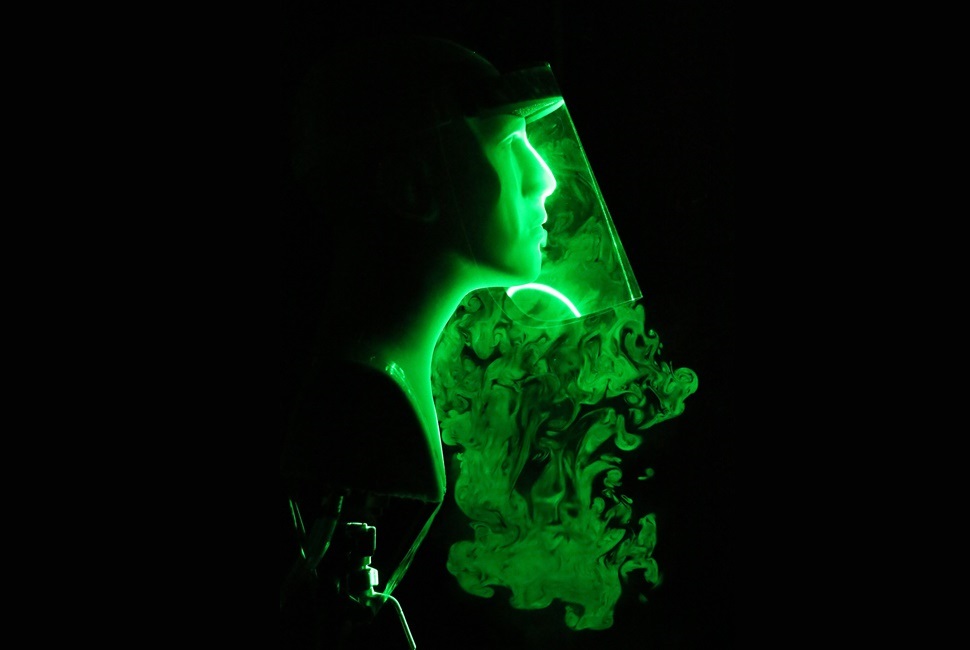Face Shield or Face Mask to Stop the Spread of COVID-19?

Florida Atlantic University, College of Engineering and Computer Science
If the United States Centers for Disease Control and Prevention (CDC) guidelines aren’t enough to convince you that face shields alone shouldn’t be used to stop the spread of COVID-19, then maybe a new visualization study will.
To increase public awareness about the effectiveness of face shields alone as well as face masks with exhalation valves, researchers from Florida Atlantic University’s College of Engineering and Computer Science used qualitative visualizations to test how face shields and masks with valves perform in impeding the spread of aerosol-sized droplets. Widespread public use of these alternatives to regular masks could potentially have an adverse effect on mitigation efforts.
For the study, just published in the journal Physics of Fluids, researchers employed flow visualization in a laboratory setting using a laser light sheet and a mixture of distilled water and glycerin to generate the synthetic fog that made up the content of a cough-jet. They visualized droplets expelled from a mannequin’s mouth while simulating coughing and sneezing. By placing a plastic face shield and an N95-rated face mask with a valve, they were able to map out the paths of droplets and demonstrate how they performed.
Results of the study show that although face shields block the initial forward motion of the jet, the expelled droplets move around the visor with relative ease and spread out over a large area depending on light ambient disturbances. Visualizations for the face mask equipped with an exhalation port indicate that a large number of droplets pass through the exhale valve unfiltered, which significantly reduces its effectiveness as a means of source control.
“From this latest study, we were able to observe that face shields are able to block the initial forward motion of the exhaled jet, however, aerosolized droplets expelled with the jet are able to move around the visor with relative ease,” said Manhar Dhanak, Ph.D., department chair, professor, and director of SeaTech, who co-authored the paper with Siddhartha Verma, Ph.D., lead author and an assistant professor; and John Frankenfeld, a technical professional, all within FAU’s Department of Ocean and Mechanical Engineering. “Over time, these droplets can disperse over a wide area in both lateral and longitudinal directions, albeit with decreasing droplet concentration.”
To demonstrate the performance of the face shield, researchers used a horizontal laser sheet in addition to a vertical laser sheet revealing how the droplets cross the horizontal plane. Not only did the researchers observe forward spread of the droplets, they found that droplets also spread in the reverse direction. Notably, face shields impede forward motion of the exhaled droplets to some extent, and masks with valves do so to an even lesser extent. However, once released into the environment, the aerosol-sized droplets get dispersed widely depending on light ambient disturbances.
Like the N-95-rated face mask used in this study, other types of masks such as certain cloth-based masks that are available commercially also come equipped with one to two exhale ports, located on either side of the facemask. The N95-rated face mask with the exhale valve used in this study had a small amount of exhaled droplets that escaped from the gap between the top of the mask and the bridge of the nose. Moreover, the exhalation port significantly reduced the effectiveness of the mask as a means of source control, as a large number of droplets passed through the valve unfiltered and unhindered.
“There is an increasing trend of people substituting regular cloth or surgical masks with clear plastic face shields as well as using masks that are equipped with exhalation valves,” said Verma. “A driving factor for this increased adoption is better comfort compared to regular masks. However, face shields have noticeable gaps along the bottom and the sides, and masks with exhalation ports include a one-way valve which restricts airflow when breathing in, but allows free outflow of air. The inhaled air gets filtered through the mask material, but the exhaled breath passes through the valve unfiltered.”
The researchers say that the key takeaway from this latest study illustrates that face shields and masks with exhale valves may not be as effective as regular face masks in restricting the spread of aerosolized droplets.
Despite the increased comfort that these alternatives offer, they say it may be preferable to use well-constructed, high quality cloth or surgical masks that are of a plain design, instead of face shields and masks equipped with exhale valves. Widespread public adoption of the alternatives, in lieu of regular masks, could potentially have an adverse effect on ongoing mitigation efforts against COVID-19.
“The research conducted by professors Dhanak and Verma on the importance of proper face coverings to stop the spread of COVID-19 has literally illuminated the world,” said Stella Batalama, Ph.D., dean of FAU’s College of Engineering and Computer Science. “While broad acceptance regarding the need for face coverings has risen steadily, there is an increasing trend of people who are substituting regular cloth or surgical masks with clear plastic face shields, and with masks equipped with exhalation valves. This latest research provides important evidence to further support CDC guidelines and inform the public to make better selections in their choice for face coverings for their benefit and for public safety.”
-FAU-
Tags: faculty and staff | engineering | research | coronavirus | technology